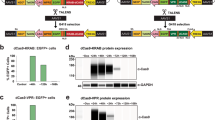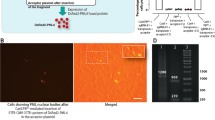Abstract
Integrative gene transfer methods are limited by variable transgene expression and by the consequences of random insertional mutagenesis that confound interpretation in gene-function studies and may cause adverse events in gene therapy. Site-specific integration may overcome these hurdles. Toward this goal, we studied the transcriptional and epigenetic impact of different transgene expression cassettes, targeted by engineered zinc-finger nucleases to the CCR5 and AAVS1 genomic loci of human cells. Analyses performed before and after integration defined features of the locus and cassette design that together allow robust transgene expression without detectable transcriptional perturbation of the targeted locus and its flanking genes in many cell types, including primary human lymphocytes. We thus provide a framework for sustainable gene transfer in AAVS1 that can be used for dependable genetic manipulation, neutral marking of the cell and improved safety of therapeutic applications, and demonstrate its feasibility by rapidly generating human lymphocytes and stem cells carrying targeted and benign transgene insertions.
This is a preview of subscription content, access via your institution
Access options
Subscribe to this journal
Receive 12 print issues and online access
$259.00 per year
only $21.58 per issue
Buy this article
- Purchase on Springer Link
- Instant access to full article PDF
Prices may be subject to local taxes which are calculated during checkout






Similar content being viewed by others
References
Ellis, J. Silencing and variegation of gammaretrovirus and lentivirus vectors. Hum. Gene Ther. 16, 1241–1246 (2005).
Naldini, L. Ex vivo gene transfer and correction for cell-based therapies. Nat. Rev. Genet. 12, 301–315 (2011).
Lombardo, A. et al. Gene editing in human stem cells using zinc finger nucleases and integrase-defective lentiviral vector delivery. Nat. Biotechnol. 25, 1298–1306 (2007).
Zou, J. et al. Gene targeting of a disease-related gene in human induced pluripotent stem and embryonic stem cells. Cell Stem Cell 5, 97–110 (2009).
Maeder, M.L. et al. Rapid “open-source” engineering of customized zinc-finger nucleases for highly efficient gene modification. Mol. Cell 31, 294–301 (2008).
Porteus, M.H. & Baltimore, D. Chimeric nucleases stimulate gene targeting in human cells. Science 300, 763 (2003).
Carroll, D. Progress and prospects: zinc-finger nucleases as gene therapy agents. Gene Ther. 15, 1463–1468 (2008).
Urnov, F.D., Rebar, E.J., Holmes, M.C., Zhang, H.S. & Gregory, P.D. Genome editing with engineered zinc finger nucleases. Nat. Rev. Genet. 11, 636–646 (2010).
Gondo, Y., Fukumura, R., Murata, T. & Makino, S. Next-generation gene targeting in the mouse for functional genomics. BMB Rep. 42, 315–323 (2009).
Frazer, K.A., Murray, S.S., Schork, N.J. & Topol, E.J. Human genetic variation and its contribution to complex traits. Nat. Rev. Genet. 10, 241–251 (2009).
de Boer, B.A., Ruijter, J.M., Voorbraak, F.P. & Moorman, A.F. More than a decade of developmental gene expression atlases: where are we now? Nucleic Acids Res. 37, 7349–7359 (2009).
Cartier, N. et al. Hematopoietic stem cell gene therapy with a lentiviral vector in X-linked adrenoleukodystrophy. Science 326, 818–823 (2009).
Aiuti, A. et al. Gene therapy for immunodeficiency due to adenosine deaminase deficiency. N. Engl. J. Med. 360, 447–458 (2009).
Samulski, R.J. et al. Targeted integration of adeno-associated virus (AAV) into human chromosome 19. EMBO J. 10, 3941–3950 (1991).
Liu, R. et al. Homozygous defect in HIV-1 coreceptor accounts for resistance of some multiply-exposed individuals to HIV-1 infection. Cell 86, 367–377 (1996).
Smith, J.R. et al. Robust, persistent transgene expression in human embryonic stem cells is achieved with AAVS1-targeted integration. Stem Cells 26, 496–504 (2008).
Henckaerts, E. et al. Site-specific integration of adeno-associated virus involves partial duplication of the target locus. Proc. Natl. Acad. Sci. USA 106, 7571–7576 (2009).
Hockemeyer, D. et al. Efficient targeting of expressed and silent genes in human ESCs and iPSCs using zinc-finger nucleases. Nat. Biotechnol. 27, 851–857 (2009).
Zou, J. et al. Oxidase deficient neutrophils from X-linked chronic granulomatous disease iPS cells: functional correction by zinc finger nuclease mediated safe harbor targeting. Blood 117, 5561–5572 (2011).
Matrai, J. et al. Hepatocyte-targeted expression by integrase-defective lentiviral vectors induces antigen-specific tolerance in mice with low genotoxic risk. Hepatology 53, 1696–1707 (2011).
Hafenrichter, D.G. et al. Quantitative evaluation of liver-specific promoters from retroviral vectors after in vivo transduction of hepatocytes. Blood 84, 3394–3404 (1994).
Okuyama, T. et al. Liver-directed gene therapy: a retroviral vector with a complete LTR and the ApoE enhancer-alpha 1-antitrypsin promoter dramatically increases expression of human alpha 1-antitrypsin in vivo. Hum. Gene Ther. 7, 637–645 (1996).
Miao, C.H. et al. Inclusion of the hepatic locus control region, an intron, and untranslated region increases and stabilizes hepatic factor IX gene expression in vivo but not in vitro. Mol. Ther. 1, 522–532 (2000).
Ogata, T., Kozuka, T. & Kanda, T. Identification of an insulator in AAVS1, a preferred region for integration of adeno-associated virus DNA. J. Virol. 77, 9000–9007 (2003).
Li, C. et al. A small regulatory element from chromosome 19 enhances liver-specific gene expression. Gene Ther. 16, 43–51 (2009).
Zhou, V.W., Goren, A. & Bernstein, B.E. Charting histone modifications and the functional organization of mammalian genomes. Nat. Rev. Genet. 12, 7–18 (2011).
Cavazzana-Calvo, M. et al. Transfusion independence and HMGA2 activation after gene therapy of human beta-thalassaemia. Nature 467, 318–322 (2010).
Papapetrou, E.P. et al. Genomic safe harbors permit high beta-globin transgene expression in thalassemia induced pluripotent stem cells. Nat. Biotechnol. 29, 73–78 (2011).
Jacquier, A. The complex eukaryotic transcriptome: unexpected pervasive transcription and novel small RNAs. Nat. Rev. Genet. 10, 833–844 (2009).
Takahashi, K. et al. Induction of pluripotent stem cells from adult human fibroblasts by defined factors. Cell 131, 861–872 (2007).
Miller, J.C. et al. An improved zinc-finger nuclease architecture for highly specific genome editing. Nat. Biotechnol. 25, 778–785 (2007).
Bondanza, A. et al. Suicide gene therapy of graft-versus-host disease induced by central memory human T lymphocytes. Blood 107, 1828–1836 (2006).
Kaneko, S. et al. IL-7 and IL-15 allow the generation of suicide gene-modified alloreactive self-renewing central memory human T lymphocytes. Blood 113, 1006–1015 (2009).
Riddell, S.R. & Greenberg, P.D. The use of anti-CD3 and anti-CD28 monoclonal antibodies to clone and expand human antigen-specific T cells. J. Immunol. Methods 128, 189–201 (1990).
Vescovi, A.L. et al. Isolation and cloning of multipotential stem cells from the embryonic human CNS and establishment of transplantable human neural stem cell lines by epigenetic stimulation. Exp. Neurol. 156, 71–83 (1999).
Vescovi, A.L. & Snyder, E.Y. Establishment and properties of neural stem cell clones: plasticity in vitro and in vivo. Brain Pathol. 9, 569–598 (1999).
Neri, M. et al. Efficient in vitro labeling of human neural precursor cells with superparamagnetic iron oxide particles: relevance for in vivo cell tracking. Stem Cells 26, 505–516 (2008).
Watanabe, K. et al. A ROCK inhibitor permits survival of dissociated human embryonic stem cells. Nat. Biotechnol. 25, 681–686 (2007).
Roy, N.S. et al. Functional engraftment of human ES cell-derived dopaminergic neurons enriched by coculture with telomerase-immortalized midbrain astrocytes. Nat. Med. 12, 1259–1268 (2006).
Pfaffl, M.W. A new mathematical model for relative quantification in real-time RT-PCR. Nucleic Acids Res. 29, e45 (2001).
Zhao, S. & Fernald, R.D. Comprehensive algorithm for quantitative real-time polymerase chain reaction. J. Comput. Biol. 12, 1047–1064 (2005).
Hellemans, J., Mortier, G., De Paepe, A., Speleman, F. & Vandesompele, J. qBase relative quantification framework and software for management and automated analysis of real-time quantitative PCR data. Genome Biol. 8, R19 (2007).
Lee, T.I., Johnstone, S.E. & Young, R.A. Chromatin immunoprecipitation and microarray-based analysis of protein location. Nat. Protoc. 1, 729–748 (2006).
Wuarin, J. & Schibler, U. Physical isolation of nascent RNA chains transcribed by RNA polymerase II: evidence for cotranscriptional splicing. Mol. Cell Biol. 14, 7219–7225 (1994).
Masternak, K., Peyraud, N., Krawczyk, M., Barras, E. & Reith, W. Chromatin remodeling and extragenic transcription at the MHC class II locus control region. Nat. Immunol. 4, 132–137 (2003).
Acknowledgements
We thank B. Celona, A. Anselmo and F. Ungaro for help with some experiments, A. Agresti, M. Bianchi and D. Gabellini for critical discussion, C. Di Serio and A. Nonis for statistical counseling, K. Ponder (Washington University, St. Louis), C. Miao (University of Washington, Seattle) and A. Recchia (University of Modena and Reggio Emilia) for providing reagents. Research was supported by Telethon (Telethon Institute for Gene Therapy grant), 7th EU Framework Programme (grant agreement 222878, PERSIST), European Research Council Advanced grant (249845 Targeting Gene Therapy), Fondazione Cariplo (Nobel Project) to L.N., Italian Ministry of Health (Giovani Ricercatori) to V.B.; Telethon (TGT06B02) to A.G.; Italian Ministry of Research and University (Ideas), Italian Ministry of Health (Giovani Ricercatori), Associazione Italiana per la Ricerca sul Cancro and Fondazione Cariplo to C.B.
Author information
Authors and Affiliations
Contributions
A.L., D.C., P.G., B.D.S., E.P. and D.F.C. designed and performed experiments, and interpreted data. M.N., Z.M., A.C., P.L.R., M.D. and O.M.P. performed experiments and interpreted data. M.C.H. and P.D.G. provided ZFNs. A.G., V.B. and C.B. coordinated NSC, iPSC and T-cell work, respectively. A.L. and L.N. conceived the project, coordinated all work and wrote the paper.
Corresponding author
Ethics declarations
Competing interests
M.C.H. and P.D.G. are employees of Sangamo BioSciences Inc.
Supplementary information
Supplementary Text and Figures
Supplementary Figures 1–13, Supplementary Tables 1–6 (PDF 6622 kb)
Rights and permissions
About this article
Cite this article
Lombardo, A., Cesana, D., Genovese, P. et al. Site-specific integration and tailoring of cassette design for sustainable gene transfer. Nat Methods 8, 861–869 (2011). https://doi.org/10.1038/nmeth.1674
Received:
Accepted:
Published:
Issue Date:
DOI: https://doi.org/10.1038/nmeth.1674
This article is cited by
-
Ribosomal protein L24 mediates mammalian microRNA processing in an evolutionarily conserved manner
Cellular and Molecular Life Sciences (2024)
-
Integrating Omics and CRISPR Technology for Identification and Verification of Genomic Safe Harbor Loci in the Chicken Genome
Biological Procedures Online (2023)
-
A strain of Vibrio alginolyticus isolated from Azumapecten farreri and its pathogenic mechanism using CRISPR-Cas9 technology
Biotechnology Letters (2023)
-
Establishment and characterization of a novel human induced pluripotent stem cell line stably expressing the iRFP720 reporter
Scientific Reports (2022)
-
Intron-encoded cistronic transcripts for minimally invasive monitoring of coding and non-coding RNAs
Nature Cell Biology (2022)



